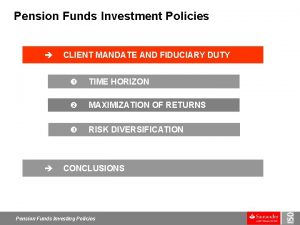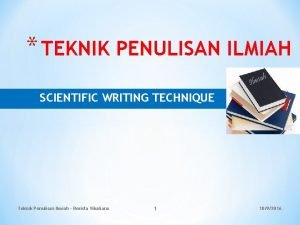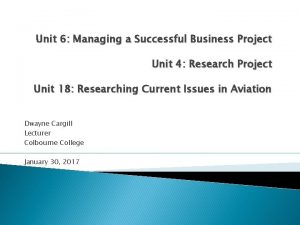Successful Scientific Writing Paul Z Siegel M D








































































- Slides: 72

Successful Scientific Writing Paul Z. Siegel, M. D. , M. P. H. Based on materials developed in collaboration with Richard A. Goodman, M. D. , J. D.

• in close proximity to • the predominant number of • in a large number of cases • on a previous occasion • in the absence of • with regard to • at some future time • due to the fact that • serves the function of being - near

I am a bear of very little brain… and long words bother me.

A Dictionary of Useful Research Phrases From Thurlbeck, WM. Glasnost and communication. Am Rev Respir Dis 1989; 139: 282 -283.

A Dictionary of Useful Research Phrases "It has long been known. . . "

A Dictionary of Useful Research Phrases "It has long been known. . . " I didn't look up the original references.

A Dictionary of Useful Research Phrases "It has long been known. . . " I didn't look up the original references. "It is believed that. . . "

A Dictionary of Useful Research Phrases "It has long been known. . . " I didn't look up the original references. "It is believed that. . . " I think.

A Dictionary of Useful Research Phrases "It has long been known. . . " I didn't look up the original references. "It is believed that. . . " I think. "It is generally believed that. . . "

A Dictionary of Useful Research Phrases "It has long been known. . . " I didn't look up the original references. "It is believed that. . . " I think. "It is generally believed that. . . " My friends think so too.

A Dictionary of Useful Research Phrases "It has long been known. . . " I didn't look up the original references. "It is believed that. . . " I think. "It is generally believed that. . . " My friends think so too. "Thanks are due to Joe Blow for assistance with the experimental work, and George Fink for valuable discussions. ”

A Dictionary of Useful Research Phrases "It has long been known. . . " I didn't look up the original references. "It is believed that. . . " I think. "It is generally believed that. . . " My friends think so too. "Thanks are due to Joe Blow for assistance with the experimental work, and George Fink for valuable discussions. ” Blow did the work. Fink explained to me what it meant.

A Dictionary of Useful Research Phrases "It has long been known. . . " I didn't look up the original references. "It is believed that. . . " I think. "It is generally believed that. . . " My friends think so too. "Thanks are due to Joe Blow for assistance with the experimental work, and George Fink for valuable discussions. ” Blow did the work. Fink explained to me what it meant. "Correct within an order of magnitude. . . "

A Dictionary of Useful Research Phrases "It has long been known. . . " I didn't look up the original references. "It is believed that. . . " I think. "It is generally believed that. . . " My friends think so too. "Thanks are due to Joe Blow for assistance with the experimental work, and George Fink for valuable discussions. ” Blow did the work. Fink explained to me what it meant. "Correct within an order of magnitude. . . " Wrong.

A Dictionary of Useful Research Phrases "It has long been known. . . " I didn't look up the original references. "It is believed that. . . " I think. "It is generally believed that. . . " My friends think so too. "Thanks are due to Joe Blow for assistance with the experimental work, and George Fink for valuable discussions. ” Blow did the work. Fink explained to me what it meant. "Correct within an order of magnitude. . . " Wrong. "A statistically oriented projection. . . "

A Dictionary of Useful Research Phrases "It has long been known. . . " I didn't look up the original references. "It is believed that. . . " I think. "It is generally believed that. . . " My friends think so too. "Thanks are due to Joe Blow for assistance with the experimental work, and George Fink for valuable discussions. ” Blow did the work. Fink explained to me what it meant. "Correct within an order of magnitude. . . " Wrong. "A statistically oriented projection. . . " Wild guess.

PURPOSE • Communicate more effectively

PURPOSE • Communicate more effectively • Publish more efficiently


Communicate effectively

To assess reliability of the questionnaire, a test-retest study was conducted. Agreement was high for sociodemographic variables. Reliability of information on chronic conditions was also high. “Do ‘reliability’ and ‘agreement’ mean the same thing?

To assess reliability of the questionnaire, a test-retest study was conducted. Agreement Reliability was high for sociodemographic variables. Reliability of information on chronic conditions was also high.

To assess reliability of the questionnaire, a test-retest study was conducted. Reliability was high for sociodemographic variables and chronic conditions. • Clear • Smooth

? ? reliability agreement reliability

? ? reliability agreement reliability of thought

If heterosexual transmission was, in fact, the mode of HIV infection for persons who reported other risks as well as heterosexual contact, for persons who are currently reported without risks but who may be reclassified in the future to the heterosexual‑contact category, as well as for persons formerly classified as "Pattern II – heterosexually acquired, " then 12% of cumulative and 16% of cases reported in 1993 may be attributable to heterosexual transmission. or ?

If heterosexual transmission was, in fact, the mode of HIV infection for persons who reported other risks as well as heterosexual contact, for persons who are currently reported without risks but who may be reclassified in the future to the heterosexual‑contact category, as well as for persons formerly classified as "Pattern II – heterosexually acquired, " then 12% of cumulative and 16% of cases reported in 1993 may be attributable to heterosexual transmission. Strain factors • long sentences (>25 words) • conjecture

If heterosexual transmission was, in fact, the mode of HIV infection for persons who reported other risks as well as heterosexual contact, for persons who are currently reported without risks but who may be reclassified in the future to the heterosexual‑contact category, as well as for persons formerly classified as "Pattern II – heterosexually acquired, " then 12% of cumulative and 16% of cases reported in 1993 may be attributable to heterosexual transmission. Conjecture

SECTIONS OF A SCIENTIFIC ARTICLE 2. ABSTRACT 3. INTRODUCTION 4. METHODS 5. RESULTS 6. DISCUSSION

SECTIONS OF A SCIENTIFIC ARTICLE 1. TITLE 2. ABSTRACT 3. INTRODUCTION 4. METHODS 5. RESULTS 6. DISCUSSION

The ABSTRACT Purpose: to highlight key points from the major sections of the article Component of abstract Abstracted from ● ● Major purpose of study Basic procedures Main findings Principal conclusions Methods Results Conclusions

The ABSTRACT Purpose: to highlight key points from the major sections of the article Component of abstract Abstracted from ● ● Major purpose of study Basic procedures Main findings Principal conclusions Introduction Methods Results Conclusions

The ABSTRACT Purpose: to highlight key points from the major sections of the article Component of abstract Abstracted from ● ● Major purpose of study Basic procedures Main findings Principal conclusions Introduction Methods Results Conclusions List Medical Subject Headings (Me. SH) key words under the abstract Emphasize what is new and useful.

Emphasize what is new and useful.

Screening research papers by reading abstracts “Please get the abstract right, because we may use it alone to assess your paper. ” -- British Medical Journal

Reliability of Information on Chronic Disease Risk Factors Collected in the Missouri Behavioral Risk Factor Surveillance System Abstract (initial draft - 183 words)

Editing • SUBSTANCE – Mistakes – Ambiguity – Missing key info • STYLE

PURPOSE The Behavioral Risk Factor Surveillance System (BRFSS) is widely used by state health agencies to measure the prevalence of chronic disease risk factors. Despite the widespread use of BRFSS, few studies exist on the reliability and validity of BRFSS-collected data. To assess the reliability of the Missouri BRFSS. . .

The Behavioral Risk Factor Surveillance System (BRFSS) is widely used by state health agencies to measure the prevalence of chronic disease risk factors. Despite the widespread use of BRFSS, few studies exist on the reliability and validity of BRFSS-collected data. To assess the reliability of the Missouri BRFSS. . . The Behavioral Risk Factor Surveillance System (BRFSS) is a population-based telephone survey of health-related behaviors among adults ages 18 and older that is used by nearly all state health agencies to measure the prevalence of chronic disease risk factors. Despite widespread use, the reliability of BRFSScollected data is not well described (understood. . . characterized. . . ). To assess the reliability of the Missouri BRFSS . . .

METHODS . . . , a test-retest study was conducted. The authors conducted telephone reinterviews for 222 respondents of completed BRFSS interviews from March and April 1993. The second interview was completed between six and 30 days of the first interview.

PASSIVE VOICE Expresses action without specifying who or what performed the action (the “agent” of the action is omitted) "James Watson was awarded the Nobel Prize for discovering the molecular structure of DNA. “

PASSIVE VOICE Expresses action without specifying who or what performed the action (the “agent” of the action is omitted) "James Watson was awarded the Nobel Prize for discovering the molecular structure of DNA. “ vs. "The Nobel Committee awarded James Watson the Nobel Prize for discovering the molecular structure of DNA. "

A Controlled Trial of Web-Based Diabetes Disease Management Meigs, JB et al. A Controlled Trial of Web-Based Diabetes Disease Management. Diabetes Care 26: 750757, 2003 One group of physicians (intervention group) was trained to use a web-based information management/ clinical decision support tool. The other group of physicians (control group) was not. “The study was a group randomized, controlled trial. A coin was tossed to select an intervention group and a control group. ”

Preventing Pneumococcal Disease Among Infants and Young Children “All children aged <23 months should be vaccinated with PCV 7. ” “Diffuse the locus of responsibility”

METHODS . . . , a test-retest study was conducted. The authors conducted Telephone reinterviews were conducted for 222 respondents of completed BRFSS interviews from March and April 1993. The second interview was completed between six and 30 days of the first interview.

METHODS . . . , a test-retest study was conducted. Telephone reinterviews were conducted for 222 respondents of completed BRFSS interviews from March and April 1993. The second interview was completed between six and 30 days of the first interview.

METHODS . . . , a test-retest study was conducted. Interviews from 222 of 252 respondents (response rate = 88%) who completed the survey during March and April, 1993, were repeated between six and 30 days after the original interview.

METHODS . . . , a test-retest study was conducted. Interviews from 222 of 252 respondents (response rate = 88%) who completed the survey during March and April, 1993, were repeated between six and 30 days after the original interview. What if your abstract has 210 words and the maximum is 200? Can we make this any shorter?

. . . , a test-retest study was conducted: interviews from 222 of 252 respondents (response rate = 88%) who completed the survey during March and April, 1993, were repeated between six and 30 days after the original interview. . interviews from 222 of 252 respondents who completed the survey during March and April, 1993, were repeated 6 -30 days after the original interview. 34 words → 23 words

RESULTS Agreement was high for sociodemographic variables (kappa values from 0. 85 to 1. 00). Reliability of information on chronic conditions and risk factors was also high, with kappa values from 0. 82 for hypertension to 1. 00 for current smoking status. Regarding cancer screening practices, reliability was lower for knowledge of the prostate-specific antigen test (kappa = 0. 21) than for women's cancer screening practices (i. e. , the mammogram and Pap smear). Questions on attitudes toward environmental tobacco smoke showed lower reliability than did questions on individual actions to reduce exposure to environmental tobacco

RESULTS Agreement was high for sociodemographic variables (kappa values from 0. 85 to 1. 00). Reliability of information on chronic conditions and risk factors was also high, with kappa values from 0. 82 for hypertension to 1. 00 for current smoking status. Regarding cancer screening practices, reliability was lower for knowledge of the prostate-specific antigen test (kappa = 0. 21) than for women's cancer screening practices (i. e. , the mammogram and Pap smear). Questions on attitudes toward environmental tobacco smoke showed lower reliability than did questions on individual actions to reduce exposure to environmental tobacco

RESULTS Agreement was high for sociodemographic variables (kappa values from 0. 85 to 1. 00). Reliability of information on chronic conditions and risk factors was also high, with kappa values from 0. 82 for hypertension to 1. 00 for current smoking status. Regarding cancer screening practices, reliability was lower for knowledge of the prostate-specific antigen test (kappa = 0. 21) than for women's cancer screening practices (i. e. , the mammogram and Pap smear). Questions on attitudes toward environmental tobacco smoke showed lower reliability than did questions on individual actions to reduce exposure to environmental tobacco

Agreement was high for sociodemographic variables (kappa values from 0. 85 to 1. 00). Reliability of information on chronic conditions and risk factors was also high, with kappa values from 0. 82 for hypertension to 1. 00 for current smoking status.

Regarding cancer screening practices, reliability was lower for knowledge of the prostate-specific antigen test (kappa = 0. 21) than for women's cancer screening practices (i. e. , the mammogram and Pap smear).

Questions on attitudes toward environmental tobacco smoke showed lower reliability than did questions on individual actions to reduce exposure to environmental tobacco smoke.

Reliability was high for sociodemographic variables, chronic conditions and risk factors (kappa > 0. 82). Reliability was lower for knowledge of the prostatespecific antigen test (kappa = 0. 21) than for women's cancer screening practices (kappa = 0. 59 - 0. 87). Questions on attitudes toward environmental tobacco smoke (kappa = 0. 47 - 0. 51) showed lower reliability than did questions on individual actions to reduce exposure to environmental tobacco smoke (kappa = 0. 62 - 0. 82).

Reliability was high for sociodemographic variables, chronic conditions and risk factors (kappa > 0. 82). Reliability was lower for knowledge of the prostatespecific antigen test (kappa = 0. 21) than for women's cancer screening practices (kappa = 0. 59 - 0. 87). Questions on attitudes toward environmental tobacco smoke (kappa = 0. 47 - 0. 51) showed lower reliability than did questions on individual actions to reduce exposure to environmental tobacco smoke (kappa = 0. 62 - 0. 82).

Reliability was high for sociodemographic variables, chronic conditions and risk factors (kappa > 0. 82), lower for cancer screening practices (kappa = 0. 59‑ 0. 87), and lowest for knowledge about prostate‑specific antigen testing (kappa = 0. 21). Reliability of questions about attitudes toward environmental tobacco smoke (kappa = 0. 47 -0. 51) was lower than for questions about individual actions to reduce environmental tobacco smoke (kappa = 0. 62 -0. 82).

one final detail

Reliability was highest for sociodemographic variables, chronic conditions and risk factors (kappa > 0. 82), lower for cancer screening practices (kappa = 0. 59‑ 0. 87), and lowest for knowledge about prostate‑specific antigen testing (kappa = 0. 21). Reliability of questions about attitudes toward environmental tobacco smoke (kappa = 0. 47 -0. 51) was lower than for questions about individual actions to reduce environmental tobacco smoke (kappa = 0. 62 -0. 82).

RESULTS • Original – 87 words • Revision – 65 words (and more information)

CONCLUSION These findings demonstrate the overall flexibility and utility of the BRFSS. ↓ We conclude that the reliability of most BRFSS questions is high. New, more reliable, questions to measure knowledge of prostate-specific antigen testing need to be developed.

The Abstract • Purpose RELIABILITY VALIDITY

The Abstract • Purpose RELIABILITY VALIDITY • Methods RELIABILITY

The Abstract • Purpose RELIABILITY VALIDITY • Methods RELIABILITY • Results RELIABILITY

The Abstract • Purpose RELIABILITY VALIDITY • Methods RELIABILITY • Results RELIABILITY • Conclusions FLEXIBILITY UTILITY

The Abstract • Purpose RELIABILITY VALIDITY • Methods RELIABILITY • Results RELIABILITY • Conclusions FLEXIBILITY UTILITY

The Behavioral Risk Factor Surveillance System (BRFSS), a population‑based telephone survey of health‑related behaviors among adults ages 18 and older, is used by nearly all state health agencies to measure the prevalence of chronic disease risk factors. Despite widespread use, the reliability of BRFSS‑collected data is not well described. To assess the reliability of the Missouri BRFSS, interviews from 222 of 252 respondents who completed the survey during March and April, 1993, were repeated 6‑ 30 days after the original interview. Reliability was highest for sociodemographic variables, chronic conditions and risk factors (kappa > 0. 82), lower for cancer screening practices (kappa = 0. 59‑ 0. 87), and lowest for knowledge about prostate‑specific antigen testing (kappa = 0. 21). Reliability of questions about attitudes toward environmental tobacco smoke (kappa = 0. 470. 51) was lower than for questions about individual actions to reduce environmental tobacco smoke (kappa = 0. 62 -0. 82). We conclude that the reliability of most BRFSS questions is high. New, more reliable, questions to measure knowledge of prostate‑specific antigen testing need to be developed. (165 words) summary of results + recommendation

The Behavioral Risk Factor Surveillance System (BRFSS), a population‑based telephone survey of health‑related behaviors among adults ages 18 and older, is used by nearly all state health agencies to measure the prevalence of chronic disease risk factors. Despite widespread use, the reliability of BRFSS‑collected data is not well described. To assess the reliability of the Missouri BRFSS, we conducted a test-retest study among 222 (88%) of 252 respondents who completed the survey during March and April, 1993. We also tested the flexibility and utility of the BRFSS by adding questions to the core questionnaire about use/knowledge of prostate specific antigen screening and exposure to environmental tobacco smoke. Reliability was highest for sociodemographic variables, chronic conditions and risk factors (kappa > 0. 82), lower for cancer screening practices (kappa = 0. 59 -0. 87), and lowest for knowledge about prostate‑specific antigen testing (kappa = 0. 21). Reliability of questions about attitudes toward environmental tobacco smoke (kappa = 0. 47 -0. 51) was lower than for questions about individual actions to reduce environmental tobacco smoke (kappa = 0. 62 - 0. 82). These findings demonstrate the flexibility and utility of the BRFSS as well as the high reliability of most BRFSS questions. New, more reliable, questions to measure knowledge of prostate‑specific antigen testing need to be developed. (199 words)

Structured Abstracts

Structured Abstracts Context Objective Design and Setting Patients Main Outcome Measure Results Conclusions Background Methods Results Conclusions

Structured Abstracts Context Objective Design and Setting Patients Main Outcome Measure Results Conclusions Background Methods Results Conclusions
 Academic and technical writing
Academic and technical writing Scientific inquiry vs scientific method
Scientific inquiry vs scientific method How is a scientific law different from a scientific theory?
How is a scientific law different from a scientific theory? Handmodell gehirn
Handmodell gehirn Nelson-siegel python
Nelson-siegel python Siegel actuarial
Siegel actuarial Nelson-siegel model excel
Nelson-siegel model excel Mindsight definition
Mindsight definition Führerscheinkontrolle dienstwagen
Führerscheinkontrolle dienstwagen Siegel gottes auf der stirn
Siegel gottes auf der stirn Isaac siegel
Isaac siegel Vivian siegel
Vivian siegel Risa siegel
Risa siegel Ben siegel uw
Ben siegel uw Isaac siegel
Isaac siegel Dr les siegel
Dr les siegel Jeremy siegel
Jeremy siegel Risa siegel
Risa siegel Martin siegel stabilitas
Martin siegel stabilitas Risa gluskin
Risa gluskin Scientific writing berlin
Scientific writing berlin 150 000 in scientific notation
150 000 in scientific notation The craft of scientific writing
The craft of scientific writing Scientific notation shorthand
Scientific notation shorthand How to write species name
How to write species name What are the rules for writing scientific names
What are the rules for writing scientific names What is scientific writing
What is scientific writing The science of scientific writing
The science of scientific writing Pengertian scientific writing
Pengertian scientific writing Unit 6 managing a successful business project
Unit 6 managing a successful business project Managing a successful business project assignment
Managing a successful business project assignment Unit 6 managing a successful business project
Unit 6 managing a successful business project The secrets to successful strategy execution
The secrets to successful strategy execution Servsafe a key element to a successful training program is
Servsafe a key element to a successful training program is Cat saddle thrombus
Cat saddle thrombus What was the first successful english colony in america
What was the first successful english colony in america Factors that facilitate successful integrative negotiation
Factors that facilitate successful integrative negotiation What makes communication successful
What makes communication successful What makes communication successful
What makes communication successful What makes communication successful
What makes communication successful Energy diagram
Energy diagram What are the ten essentials of a successful ffa chapter
What are the ten essentials of a successful ffa chapter Netflix perceptual map
Netflix perceptual map Foundations u.com
Foundations u.com Signs of successful relactation
Signs of successful relactation Unit 6 managing a successful business project
Unit 6 managing a successful business project Cyberpreneurship
Cyberpreneurship Lou tice quotes
Lou tice quotes The association for successful parenting
The association for successful parenting Successful marriages and families
Successful marriages and families Liberal reforms essay higher history
Liberal reforms essay higher history Human
Human One of the factors contributing
One of the factors contributing In order to be successful
In order to be successful 10 attitudes of successful workers
10 attitudes of successful workers Having a strong wish to be successful , powerful , or rich
Having a strong wish to be successful , powerful , or rich 7 habits of successful students
7 habits of successful students Planning a successful website
Planning a successful website Trust matters leadership for successful schools
Trust matters leadership for successful schools Toastmasters advanced manuals
Toastmasters advanced manuals 6 steps to successful co-teaching
6 steps to successful co-teaching The first successful british colony in north america
The first successful british colony in north america Was the counter reformation successful?
Was the counter reformation successful? What important attitudes do successful scientists possess?
What important attitudes do successful scientists possess? What purpose does the rain shower serve in pygmalion
What purpose does the rain shower serve in pygmalion Project selection and portfolio management
Project selection and portfolio management Wics model activities
Wics model activities Five keys to a successful life as an engineer
Five keys to a successful life as an engineer Strategies for successful interpersonal communication
Strategies for successful interpersonal communication Successful consultative salespeople
Successful consultative salespeople Successful
Successful Starbucks lean management
Starbucks lean management Longing, strong desire
Longing, strong desire































































































